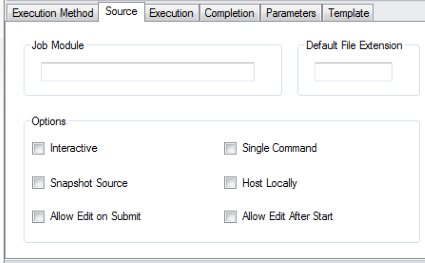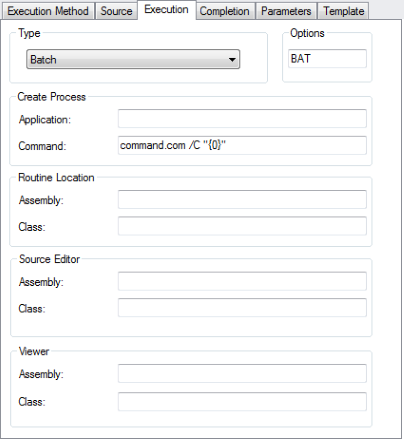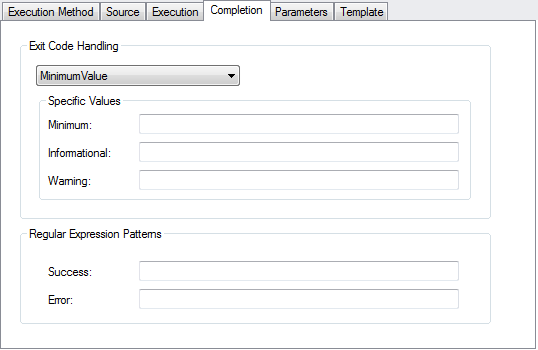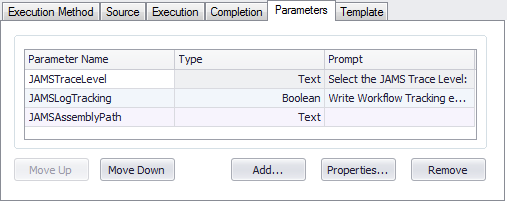An Execution Method defines how a Job executes within the JAMS environment. A default Execution Method is assigned to every Job if one is not specifically assigned.
JAMS ships with dozens of Executions Methods to run Jobs on Windows, Unix, Linux, OpenVMS, along with any operating system supporting connections using SSH or REXEC.
For detailed listing of JAMS Predefined Executions Methods, review the listing at the end of this topic.
Manually Assigning an Execution Method to a Job
To manually assign an Execution Method, open a Job’s properties and select Properties tab > Source Options. Use the File Browser button to select from a listing of available Execution Methods, as shown below.

In addition, you can customize your own Execution Methods to apply other technologies that JAMS does not interface with. Or you can modify an existing Execution Method’s functionality.
Customizing an Execution Method entails a two-step process: creating an Execution Method and modifying/updating its properties. Both steps are described in detail in the following two sections.
Creating a New Execution Method
To define a new custom Execution Method start by clicking on the shortcut to access the Execution Method View.

- Choose the Add button from the Ribbon Bar to open the Execution Method Definition Wizard.
- On the Execution Method Name page enter the name and description of the new Execution Method. Click Next.
- On the following Execution Type wizard page, select the File Browser button.

- This action opens a search list displaying other Execution Methods from which to base this new entry.
- Make a choice by double-clicking on a method name. The search list then closes and populates the Base Execution Method property.
- Choose the Finish button to add the new definition to the Execution Method View.
Modifying an Execution Method's Properties
The next step is to modify the new Execution Method’s definition properties. Or this can become a first and only step if you plan on changing an existing Execution Method.
To start, highlight and double-click an Execution Method from the list to open its definition window.
Each Execution Method is made up of six properties that correspond to the six tabs on the definitions window shown below. These properties are detailed below.

This tab includes basic identification properties including: the method name, description and date and time of the Execution Method's last revision.
Method Name
This is the unique identifier for the Execution Method parameter.
Description
This reference property is used to summarize the Execution Method definition.
Last Changed
Indicates the date and time this Execution Method parameter was last modified.
The Source tab is used to specify certain values for a Job, including Job Modules, which reference macros in a template file.

Job Module
This is the name of a text module in the template library which is used as the starting point for parsing the Job's command procedure. Entering a value in this property implies that this Job is parsed.
The template library is a combination of the macros in the BaseMacros.xml file, the file specified in the "DefaultMacroFile" configuration setting and the macros in the xml file specified in the Job's Folder definition. The BaseMacros.xml file is replaced when installing a JAMS upgrade.
 |
Caution: If you want to add custom macros you should avoid putting them in the BaseMacros.xml so that you don't lose them during an upgrade. |
 |
Note: that you can specify the starting point for parsing using either the Job Module property or the Template tab. However, you cannot use both. |
Default File Extension
Enter the default file extension for the Job's command procedure.
Options (Checkboxes)
- Interactive: when enabled, this Execution Method can interact with the desktop. Caution: this setting is not recommended since it can lead to potential security issues. The Interactive property has been included here because some applications require access to the desktop in order run properly.
- Single Command: when activated, the Execution Method uses a command instead of a command procedure.
- Snapshot Source: If enabled, the option allows JAMS to grab a copy of the source when submitting a Job.
- Host Locally: Indicates that the Job should only be hosted by the machine running the JAMS Scheduler. This setting is used for Execution Methods that need to manage connection to the Agent machine. An example would be the SSH Execution Method which executes locally and uses SSH to connect to the Agent in order to run the actual job.
- Allow Edit on Submit: when activated, this checkbox permits the source to be edited when manually submitting the Job.
- Allow Edit After Start: when activated, this setting permits the source to be edited after a manually submitted Job has started.
This tab incorporate several sections that are detailed below:

Type
This dropdown allows you to choose the Execution Method type. The supported types are:
-
Agent runs a Job using a JAMS Agent.
-
Batch runs a Job by creating a process with a Job or Command.
-
Routine executes a Job using the specified class from a specified assembly using the IJAMSHost interface.
-
Rexec runs a Job by connecting to a rexec daemon.
-
SSH Agent executes a Job using a secure shell commands with JAMS AgentX.
Options
This property specifies options unique to the Execution Method and IJAMSHost implementation.
Create Process
Includes values that are passed to CreateProcess as the application or command argument.
- Application: is the value passed to CreateProcess as the application argument.
- Command: is the value passed to CreateProcess as the command argument.
Routine Location
This is used when the type is set to Routine. When JAMS executes the Job it loads the specified assembly, class and call methods from the IJAMSHost interface.
- Assembly: the assembly name containing the class.
- Class: the class that executes the job. This class must implement IJAMSHost.
Source Editor
The Source Editor is used by the JAMS Client to edit the Job’s source code. When using a text editor make sure to leave the Assembly and Class properties empty. You can create custom editors for each custom Execution Method. Each editor displays on the Job definition’s Source tab.
Viewer
This is used for viewing the progress of an executing Job, which is often a Workflow Job.
- Assembly: the assembly name containing the class.
- Class: the class that executes the job. This class must implement IJAMSHost.
Exit Code Handling
This dropdown controls how a processed exit code should be interpreted. Depending on the Exit Code Handling selection, choose the specific parameter values listed below:

- ZeroIsGood
- OneIsGood
- EvenIsGood
- OddIsGood
- PositiveIsGood
- MessageCode
- OpenVMSMessageCode
- SpecificGood
- SpecificBad
- MinimumValue
Enter the Minimum, Informational and Warning values.
Regular Expression Patterns
Specify a regular expression pattern that is matched against both success and error log file outputs.
Execution Method parameters work the same way as Parameters within Job definitions and apply to all Jobs using this Execution Method. To insert a new Parameter, select the Add button on the Parameters tab to access the Add a Parameter wizard.

 |
Note: if a Job has a Parameter with the same name as the Execution Method Parameter, the Job definition is used. |
For a description of Parameters, go the topic: Job Properties – Parameters.
Templates provide an easy way to include standard pre and post processing for your Jobs.
At submit time JAMS parses a Job source using either the template defined on this tab or the module defined in the Job Module property for the Job’s source code. Use the built-in text editor to edit the template for this Execution Method.
The example below sets up a simple template that maps two network drives, inserts the Job’s source code and executes a LogJobComplete program:
| LogJobComplete |
Copy Code
|
|---|---|
NET USE E: \\MyServer\EShare NET USE F: \\MyServer\FShare <<JAMS.Current.Source>> C:\LogJobComplete.exe <<JAMS.Job.JobName>> |
|
Predefined Execution Methods
JAMS ships with dozens of Predefined Execution Methods that can run a variety of Jobs on Windows, Linux, UNIX and and other operating systems detailed below.
| Method | Description | OS |
| Banner | Executes a Banner job | Windows |
| BannerWin | Executes a Banner job on Windows | Windows |
| Command | Used to run a Windows batch procedure | Windows |
| CRJobV12 | Crystal Reports Job using Crystal Reports version 12 | Windows |
| CRJobV13 | Crystal Reports Job using Crystal Reports version 13 | Windows |
| File Transfer | Defines a file Transfer (FTP, SFTP, or FTP/SSL) | Windows |
| FileTransferV1 | Defines a file Transfer (FTP, SFTP, or FTP/SSL) Replaces File Transfer from V6.4.51 and under | Windows |
| InformaticaCloud | Executes an Informatica Cloud task. | Windows |
| JAMS Report | Generates a JAMS Report | Windows |
| JDEJob | Runs a J.D. Edwards job | Windows |
| JDEJobSsh | Runs a J.D. Edwards job on Linux via SSH | Windows |
| MF Job | Executes a Micro Focus Job | Windows |
| MSDAX2012Job | Executes a Microsoft Dynamics AX job | Windows |
| NeoBatchCatalog | Executes a NeoBatch Job from a NeoBatch Catalog | Windows |
| NeoBatchJcl | Executes NeoBatch Job from JCL stored in JAMS | Windows |
| NetezzaBackup | Runs a Netezza backup job using SSH | Unix, Linux |
| NetezzaLoad | Runs a Netezza Load job using SSH | Unix, Linux |
| NetezzaSQL | Executes a Netezza Query job using SSH | Unix, Linux |
| OdbcCommand | Executes ODBC Commands | Windows |
| OleDbCommand | Executes OLEDB Commands | Windows |
| OracleEBSConcurrent | Runs an Oracle EBS Concurrent process | AIX, HP-UX, Linux, Solaris |
| OracleEBSJobSsh | Runs an Oracle E-Business Suite Job via SSH | AIX, HP-UX, Linux, Solaris |
| OracleEBSRequestSet | Executes an Oracle ES Set job | AIX, HP-UX, Linux, Solaris |
| OracleStoredProc | Executes an Oracle Stored Procedure Job | AIX, HP-UX, Linux, Solaris |
| OS400 | Runs IBM System i, OS/400 jobs | IBM System i |
| PeopleSoftJobSsh | Executes a PeopleSoft job using SSH | PeopleSoft |
| PeopleSoftJobWindows | Runs a PeopleSoft job on Windows | PeopleSoft |
| PowerShell | Runs a PoweShell script on Windows | Windows |
| PowerShell32 | Runs a PoweShell script (32 bit) | Windows |
| PowerShellParsed | Runs a parsed PoweShell script on Windows | Windows |
| PowerShellParsed32 | Runs a parsed PoweShell script (32 bit) | Windows |
| Rexec | Issues a command using rexec | Any |
| RexecScript | Runs a shell script on an rexec server | Any |
| SAPDataService | Executes a SAP Business Objects Data Services Job | SAP |
| SAPJobV2 | Executes a SAP multi-step job | SAP |
| SAPStandardJob | Executes a SAP single-step job | SAP |
| SAPProcessChain | Executes an SAP Process Chain | SAP |
| SQLAgent | Runs SQL Server Agent Job | Windows |
| SQLCommand | Runs SQL commands | Windows |
| SQLStoredProc | Executes an SQL Stored Procedure | Windows |
| SSH | Runs a Secure Shell | Any |
| SSHAgent | Deploys JAMS AgentX using SSH | AIX, HP-UX, Linux, Solaris |
| SSHDeploy | Deploys JMAS AgentX using AgentX | Windows |
| SSHNetworkConnect | A Sample SSHNetworkConnect Execution Method | OpenVMS |
| SSHOpenVMS | Runs a Secure Shell with OpenVMS using prompt matching | OpenVMS |
| SSHPrompt | Runs a Secure Shell using prompt matching | Any |
| SSIS | Runs SQL Server Integration Services | Windows |
| SSISDirect | Runs SQL Server Integration Services | Windows |
| SSRS | SQL Server Reporting Services | Windows |
| UnixScript | Run a Unix Script based on the shebang on the first line | Unix/Linux |
| UnixShell | Run a shell script on a Unix Server. | Unix/Linux |
| Vbs | Executes a VB Script | Windows |
| VMS | Runs an OpenVMS DCL Command Procedure | OpenVMS |
| VMSParsed | Runs an OpenVMS DCL Command Parsed Procedure | OpenVMS |
| WindowsDeploy | Deploys a JAMS Agent to a Windows machine | Windows |
| Workflow | Runs a Windows Workflow job | Windows |
| zOS | Executes an IBM zOS job | zOS |